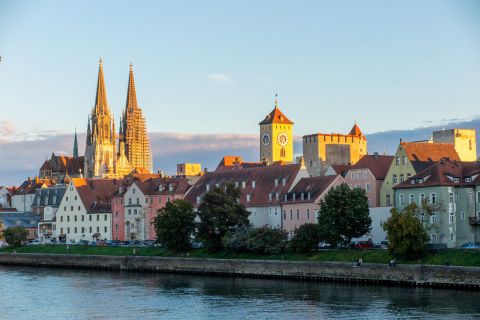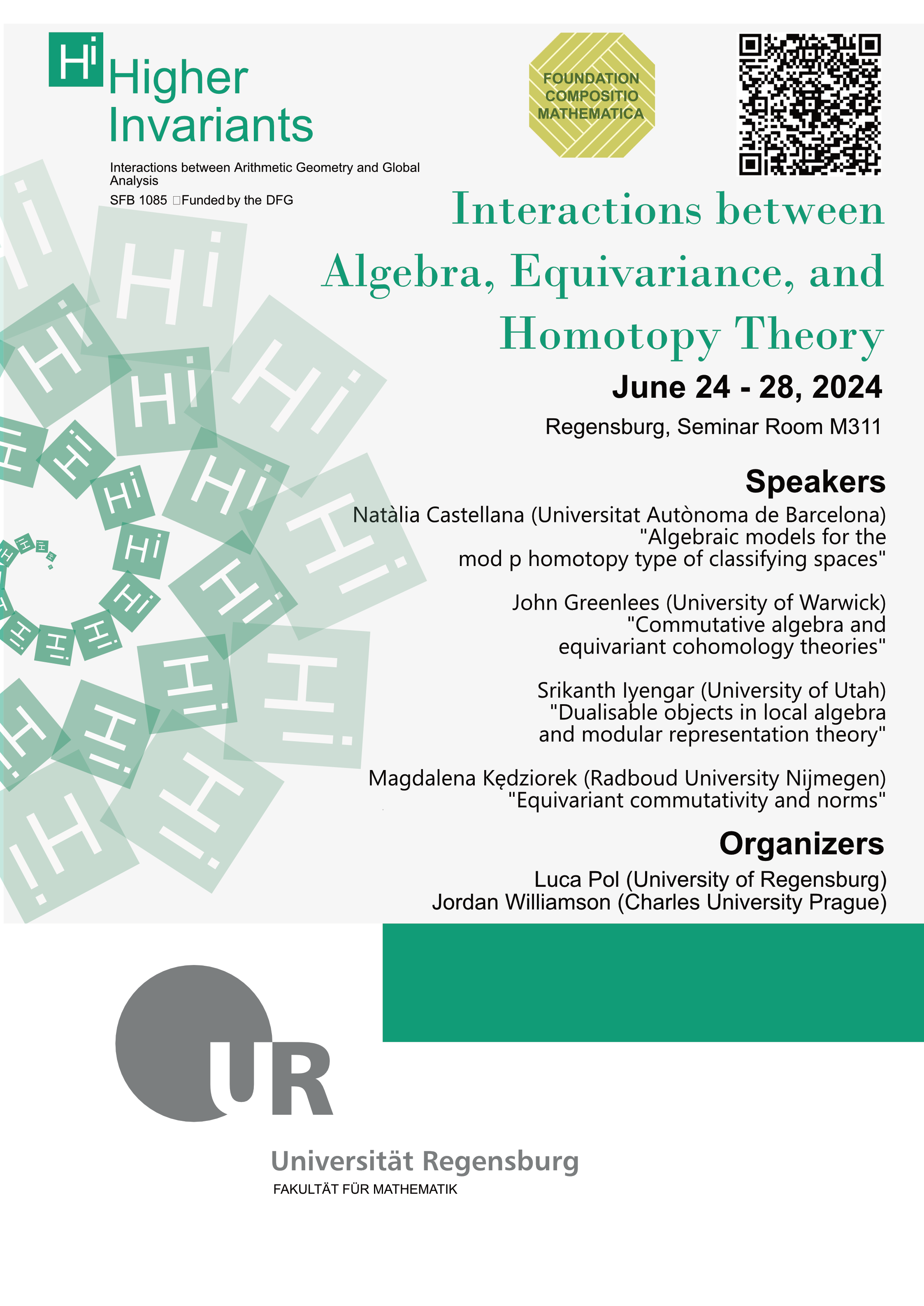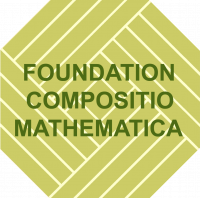

HomeAboutPeopleEventsResearchRTGGuest ProgrammeImpressum
Summer School Interactions between Algebra, Equivariance, and Homotopy Theory (June 24-28, 2024)
Aim and Scope
The aim of the summer school is to bring
together researchers in algebra and homotopy theory, especially those with a link to equivariant
methods, and seek to encourage collaboration and interaction between these different, yet
deeply related fields. A key focus of this summer school is on early career researchers.
Invited Speakers
- John Greenlees "Commutative algebra and equivariant cohomology theories",
- Natalia Castellana "Algebraic models for the mod p homotopy type of classifying spaces",
- Magdalena Kędziorek "Equivariant commutativity and norms",
- Srikanth Iyengar "Dualisable objects in local algebra and modular representation theory".
There will also be a series of contributed talks by participants.
Practical Information
City of Regensburg: Regensburg is a Unesco World Heritage site that is famous for its well-preserved medieval city center and its beautiful Gothic cathedral.
Further information about Regensburg can be found here.
Internet: Access to eduroam and BayernWLAN is available throughout the Mathematics Building.
Accomodation: Regensburg is a tourist destination and we encourage guests to book their rooms as early as possible. Here is a list of hotels in the area:
- Hotel Münchner Hof (In the city center, one must take a bus to the University.)
- Hotel Kaiserhof am Dom (In the city center, one must take a bus to the University.)
- Hotel Jakob (In the city center, one must take a bus to the University.)
- Hotel Apollo (Near the University, but limited eating options nearby.)
- Hotel Wiendl (Between the city center and the University.)
- Hotel Central (Between the city center and the University, one must take a bus to the University.)
Family Friendly Campus: Our UR family service offers various rooms for families and services. If you need further information look here.
Venue
All lectures and research talks are in the lecture hall M311, at the 3rd floor of the Mathematics building of Regensburg University (Attention: not the department "Mathematik und Informatik" of the OTH).
One can reach the University of Regensburg by following the instructions here and see here for maps of the campus. Many of the participants will probably arrive by bus at the Central Bus Station of the university which is close to the math building, a bit more towards North (=top of the plan).
Inside of the Mathematics building, use the staircase next to the main entrance and go up to the top.
Schedule
| Time | Monday | Time | Tuesday | Time | Wednesday | Time | Thursday | Time | Friday |
|---|---|---|---|---|---|---|---|---|---|
| 9:00-9:30 | Registration | 9:30-10:30 | John Greenlees 2 | 9:30-10:30 | Natalia Castellana 2 | 9:30-10:30 | Magdalena Kedziorek 3 | 9:30-10:30 | Natalia Castellana 3 |
| 09:30-10:30 | Srikanth Iyengar 1 | 10:30-11:00 | Coffee break | 10:30-11:00 | Coffee break | 10:30-11:00 | Coffee break | 10:30-11:00 | Coffee break |
| 10:30-11:00 | Coffee break | 11:00-12:00 | Magdalena Kedziorek 2 | 11:00-12:00 | Srikanth Iyengar 2 | 11:00-12:00 | John Greenlees 3 | 11:00-11:30 | Ahina Nandy |
| 11:00-12:00 | John Greenlees 1 | 12:00-12:30 | Conference Picture | 12:00-12:30 | Gabriel Martínez de Cestafe Pumares | 12:00-12:30 | Maria Simkova | 11:30-12:00 | Jorge Eduardo Gaspar Lara |
| 12:00-12:30 | Kamil Rychlewicz | 12:30-13:30 | SFB-Lecture | 12:30-14:00 | Lunch | 12:30-14:00 | Lunch | 12:00-12:30 | Gregiore Marc |
| 12:30-14:00 | Lunch | 13:30-14:30 | Lunch | from 14:00 | Excursion | 14:00-15:00 | Srikanth Iyengar 3 | ||
| 14:00-15:00 | Magdalena Kedziorek 1 | 14:30-15:30 | Natalia Castellana 1 | 15:00-15:30 | Break | ||||
| 15.00-15.30 | Maxime Wybouw | 15:30-16:00 | Break | 15:30-16:30 | Marco Praderio Bova | ||||
| 15.30-16.00 | Break | 16:00-16:30 | Torgeir Aambø | 16:30-17:00 | Kabeer Manali Rahul | ||||
| 16.00-17.00 | Gong Show | 16:30-17:00 | Marius Verner Bach Nielsen |
| Time | Monday | Tuesday | Wednesday | Thursday | Friday |
|---|---|---|---|---|---|
| 9:00-9:30 | Registration | ||||
| 9:30-10:30 | Srikanth Iyengar 1 | John Greenlees 2 | Natalia Castellana 2 | Magdalena Kedziorek 3 | Natalia Castellana 3 |
| 10:30-11:00 | Coffee Break | ||||
| 11:00-11:30 | John Greenless 1 | Magdalena Kedziorek 2 | Srikanth Lyengar 2 | John Greenlees 3 | Ahina Nandy |
| 11:30-12:00 | Jorge Eduardo Gaspar Lara | ||||
| 12:00-12:30 | Kamil Rychlewicz | Conference Picture | Gabriel Martinez de Cestafe Pumares | Maria Simkova | Gregiore Marc |
| 12:30-13:30 | Lunch | SFB-Lecture | Lunch | ||
| 13:30-14:00 | Lunch | ||||
| 14:00-14:30 | Magdalena Kedziorek 1 | Excursion | Srikanth Lyengar 3 | ||
| 14:30-15:00 | Natalia Castellana 1 | ||||
| 15:00-15:30 | Maxime Wybouw | Break | |||
| 15:30-16:00 | Break | Marco Praderio Bova | |||
| 16:00-16:30 | Gong Show | Torgeir Aambø | |||
| 16:30-17:00 | Marius Verner Bach Nielsen | Kabeer Manali Rahul | |||
Lecture series
Natalia Castellana -- Algebraic models for the mod $p$ homotopy type of classifying spaces For finite groups, group cohomology is a field which exploits the best of both algebraic topology and homological algebra. Choosing different coefficients will reflect different properties of the classifying space and the internal structure of the group. We will focus on the Bousfield $p$-completion of the classifying space. In this case, the classical stable elements formula due to Cartan and Eilenberg shows how the mod $p$ cohomology only depends on the $p$-subgroups and its conjugacy relations. This information can be encoded in a category, the fusion category of the finite group.
How much of the mod $p$ homotopy theory can be determined by the fusion category? Work of Puig and Broto-Levi-Oliver formalize an abstract notion of a fusion system on a $p$-group, its associated classifying space and studied its homotopy theory. In these lectures, the aim is to describe this algebraic model for the local structure at a prime, and show how results in both unstable and stable homotopy theory of classifying spaces at a prime are determined by it.
References:
- Broto-Levi-Oliver, The homotopy theory of fusion systems, JAMS 16, (2003)
- Castellana, Algebraic models in the homotopy theory of classifying spaces, Handbook of homotopy theory
- Barthel-Castellana-Heard-Valenzuela, Stratification and duality for homotopical groups, Advances in Mathematics 354 (2019)
- Cantarero-Castellana-Morales, Vector bundles over p-local groups and Benson-Carlson duality, Journal of the London Mathematical Society 101 (2020)
John Greenlees -- Commutative algebra and equivariant cohomology theories
Srikanth Iyengar -- Dualisable objects in local algebra and modular representation theory
The derived category of a commutative noetherian ring is stratified (in a way that will be made precise in the lectures) by its spectrum of prime ideals. There is an analogous stratification of the stable module category of a finite group in terms of the spectrum of the cohomology ring of the group. Understanding these local strata takes us a long way towards understanding the global structure of the categories. This lecture series will be about dualisable objects in the local strata. My goal is to explain why they are of interest, and some of the special properties they possess. The local dualisable objects in a given stratum form an essentially small tensor triangulated category. The culmination of the talks will be a description of their Balmer spectrum.
Lecture 1: Tensor triangulated categories: stratification and dualisability
Lecture 2: Local regularity
Lecture 3: Locally dualisable modular representations
The basic references for these lectures are the articles:
- Local dualisable objects in local algebra (with Benson, Krause, and Pevtsova)
- Locally dualisable modular representations and local regularity (with Benson, Krause, Pevtsova)
- Locally dualizable modules abound (with Carlson)
Magdalena Kedziorek -- Equivariant commutativity and norms
Recently, equivariant homotopy theory has provided instrumental tools for solving computational and conceptual problems in algebraic topology. New developments in the field in the last decades created an incredible amount of activity. As a result, a lot of attention in equivariant homotopy theory has been given to various levels of commutativity in that setting. These levels are modelled by $N_\infty$-operads of Blumberg and Hill and they can be completely classified in terms of algebraic data of transfer systems. This in turn can be understood for many finite groups using combinatorics. There is also a framework capturing different levels of commutativity in global homotopy theory.
In this series of talks, I will concentrate on presenting this landscape and outlining how it combines with algebraic models for rational G-spectra.
Titles and Abstracts
Kamil Rychlewicz -- Equivariant cohomology theories as rings of functions
The classical Poincaré-Hopf theorem shows how to recover the Euler characteristic of a compact manifold from isolated zeros of the vector field. The work of Carrell-Liebermann and Akyildiz-Carrell extended that result, showing that in case of a smooth projective complex variety, one can recover the whole cohomology ring from the ring of functions of the zero scheme of the vector field. Theorem of Brion-Carrell extends it to equivariant cohomology for an action of a Borel of SL_2. Together with Tamas Hausel, we recently generalized the result to any reductive group, or its Borel, acting with a single zero of a regular nilpotent. The spectrum of the equivariant cohomology then shows up as a geometrically constructed zero scheme of a vector field. I will report on that result, and sketch a further circle of ideas which allows to view more general cohomology rings, e.g. for spherical varieties or certain singular varieties, as rings of functions on potentially non-affine variety.
Marius Verner Bach Nielsen -- K(n)-local homotopy in synthetic spectra
Using deformation theory one can categorify the E-Adams spectral sequence based on an Adams type spectrum E. For K(n)-local spectra one often uses the K(n)-local E_n-Adams spectral sequence, which does not directly admit a categorification. In this talk, we will propose a solution to this, by using a localization of E_n-based synthetic spectra. As a proof of concept, we compute the synthetic homotopy groups of the K(1)-local sphere. This is joint work with Torgeir Aambø.
Torgeir Aambø -- K(n)-local deformation theory
Pstragowski’s category of hypercomplete E_n-based synthetic spectra, Syn_E, acts as a one-parameter deformation between Sp_n and the derived category of E_*E-comodules. However, there is a more fundamental building block inside Sp_n — the category of K(n)-local spectra — and we can ask whether this also has an associated deformation. But, K(n)-based synthetic spectra deform to the wrong category of comodules, and hence can be interpreted as an incorrect deformation for Sp_{K(n)}. In this talk, we investigate a K(n)-local analog of Syn_E and prove that it has the correct one-parameter deformation properties. This is joint work with Marius Nielsen.
Maxime Wybouw -- Minimal models in diagrams of chain complexes
A classical theorem by Kadeishvili states that the information of the quasi-isomorphism type of an associative differential graded algebra over a field can be encoded as a minimal A_\infty structure on its homology algebra. In this talk, I will discuss generalizations of this result that allow to encode commutative multiplications and to work over more general ground rings. A motivating example is the cochain algebra of a space. One main tool is to work with diagrams of chain complexes indexed by finite sets and injections.
Conference Poster
You can download the conference poster here.
Organizers
Conference Picture
Sponsors of the conference
This conference is funded by SFB 1085 "Higher Invariants" and Foundation Compositio Mathematica




